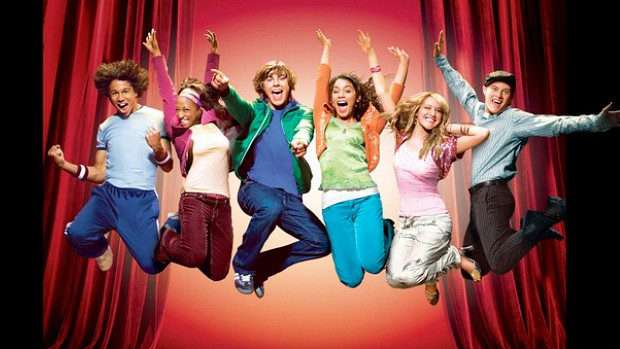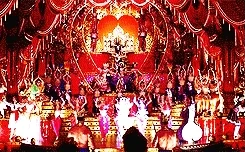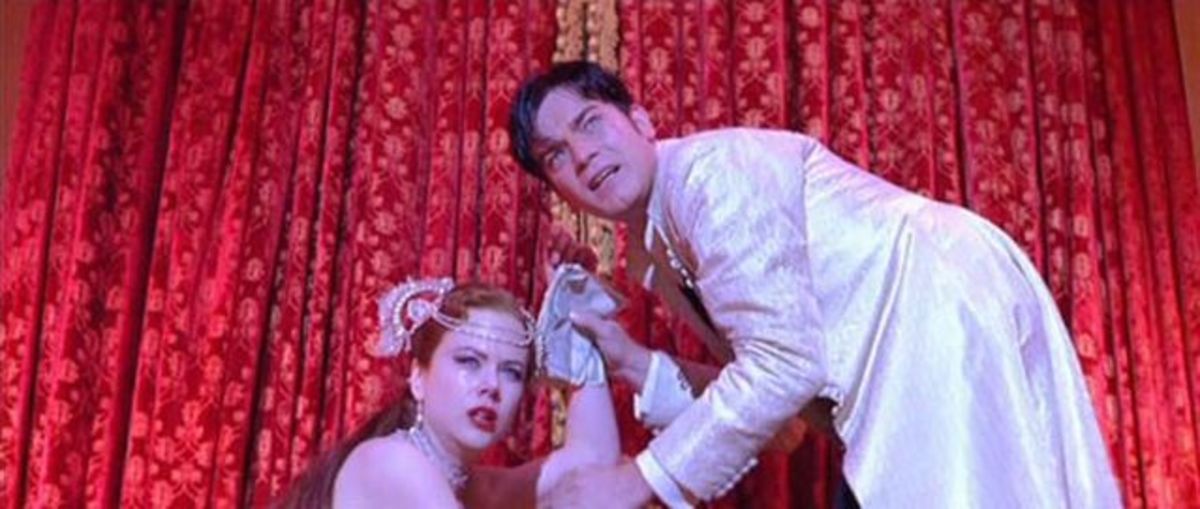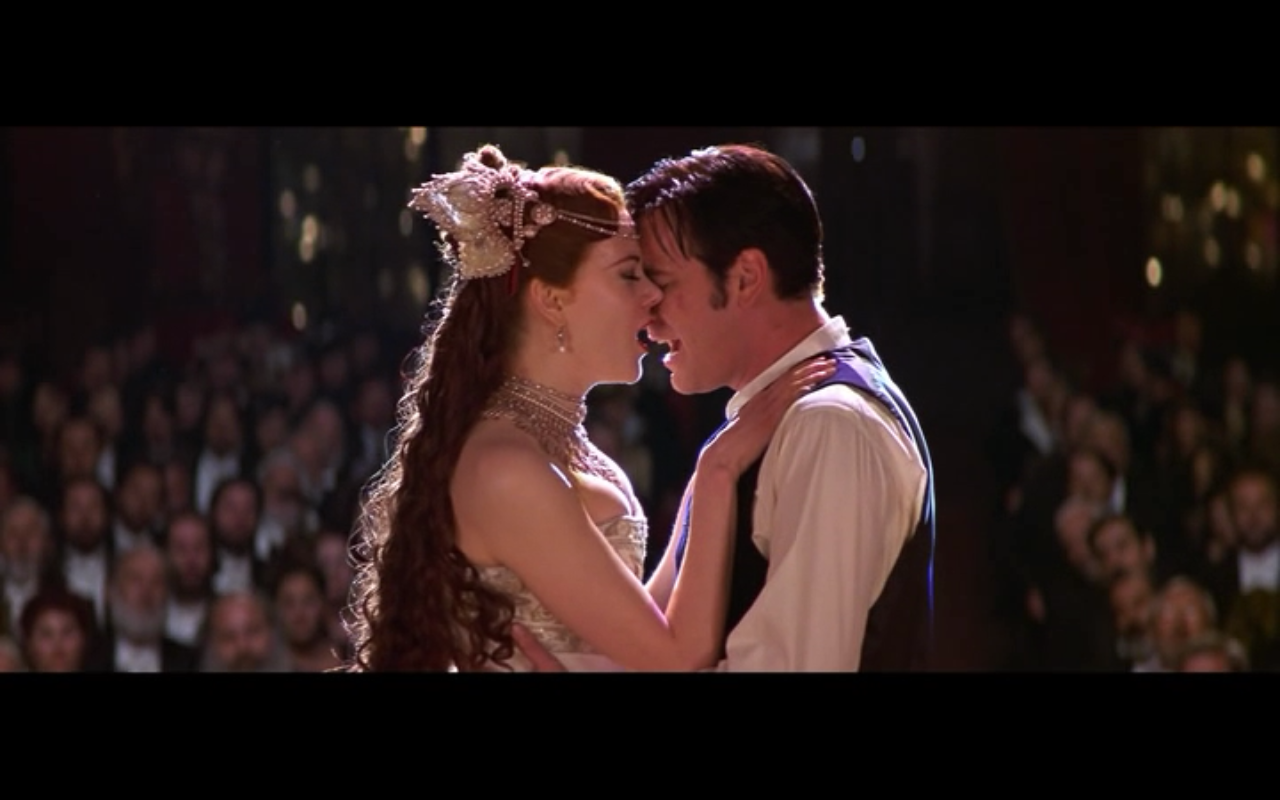 |
| Singin' in the Rain (1952) |
In short, East High is not the real world. Troy Bolton should never have attempted to cross over, and we should never expect him to. He must linger
around the musical hallways of East High forever. Always singing, never growing
up. Never facing the world as it really is.
Such is the quiet insecurity of many a musical lover: We enjoy
watching Judy Garland and Gene Kelly dance into each other’s arms in time for
the curtain call, but we know that it’s naïve to expect our own romances to work out
so neatly. This of course brings up the question, what then is the use of these
“images of liberation?” Are musicals good for anything other than a distraction
for the masses? A trap for suckers too idealistic for their own good?
Like SNL’s skit, Moulin Rouge!
functions as a response to that unwavering idealism that feels straight out of
the 1950s, but Moulin Rouge! thoughtfully dissects the assumptions, motivations, and history of the musical format, including its enthusiasm for romanticism. By embracing rather than ignoring the harsh reality we live in, Moulin Rouge!
crafts the best defense of musical idealism and finds a use for these “images
of liberation.” We need musicals not despite the state of the world but because of it.
A
Quick Introduction for the Uninitiated Reader
The story is told with a frame
narrative: our main character, hopeless romantic Christian (Ewan McGregor),
reflects on the events of the story a year after they have transpired. He recalls
coming to Paris to take part in the artistic revolution and quickly finding
himself part of a troupe of bohemian performers. They recruit him to their mission to have their stage
show, Spectacular, Spectacular!, performed on stage at the famed
cabaret, the Moulin Rouge, owned by Harold Ziddler (Jim Broadbent). When pitching
the show, Christian finds himself in the presence of courtesan and cabaret
star, Satine (Nicole Kidman). Christian’s poetic gift and boundless idealism
woo Satine, and they fall into a forbidden romance.
Christian and Satine attempt to hide their
love from the world, especially from the rich and powerful Duke (Richard Roxburgh)
to whom Satine is promised. As the charade grows more dire, Christian and Satine find themselves being torn apart by forces stronger than even that of true love, including a grave illness that silently eats away at Satine, and Christian's inescapable jealousy.
 Christian, the eternal idealist that
he is, is something of a proxy for musical protagonists from the golden age of
musicals, the clay with which the movie crafts its attitude toward musical idealism. The film’s thematic conflict is between Christian
and the ideals he espouses. Turns out
the path to true love entails more than dancing and fireworks, and even the sincerest
love is not beyond the grip of tragedy.
Christian, the eternal idealist that
he is, is something of a proxy for musical protagonists from the golden age of
musicals, the clay with which the movie crafts its attitude toward musical idealism. The film’s thematic conflict is between Christian
and the ideals he espouses. Turns out
the path to true love entails more than dancing and fireworks, and even the sincerest
love is not beyond the grip of tragedy. The thematic tension from the movie
comes from not knowing whether or not Christian will maintain his poetic world
views after colliding with reality: Is there something to Christian’s boundless
idealism, or is he just another sucker who has seen The Sound of Music one
too many times?
We can only get so far into this discussion before talking about the movie's "over-the-top-ness." If you ask someone who loves the movie to describe it in one word, you might hear them call it "vibrant" or "bold." If you ask someone who hates this movie to describe it in one word, you might hear them call it "gaudy" or "excessive."
This is a world where Christian Satine leaping from the window of her hut (a hut shaped like an elephant, incidentally) and into the clouds hanging over the Parisian night sky feels like a natural progression. Compare this movie to the Les Miserables film adaptation. That film tries to integrate the musical experience with a familiar reality. Everything there is grim and harsh, captured in unflinching realness. Moulin Rouge! is not that movie.
Moulin Rouge! has the plasticity of a Bugs Bunny cartoon, and it’s also an Othello-scale tragedy, occasionally in the same scene or even the same moment. And it’s that elasticity that leaves the entire buffet of human emotion on the table. The reason you can vacillate between these extremes of the human experience in this film is because it trains you right from the start to go from zero to sixty and back again. And the other reason is that Moulin Rouge! revels in the form's innate performativity. The film goes out of its way to tell the audience that the
film they’re watching is not “real." This is all staged.
So, if it’s not “real,” does that
automatically mean it’s “fake?” Is the entire film, and the foundation of musical storytelling, one big joke on the
audience? These are questions that musicals
have been asking for a long time.
Crash Course in Musical History
 |
| Shall We Dance (1937) |
For a world
shredded by World War II and America’s Great Depression, an afternoon with Fred
and Ginger waltzing into the sunset was a breath of fresh air, and musicals
fueled the discouraged public with much-needed optimism. That's something I feel we really need to establish: Hollywood musical as a form of entertainment rose to prominence during a time of heavy distress, for America specifically and the world at large.
Those early musicals also set the standard
for the basic narrative template for musical films. The storyline is usually
concerned with the lives of storytellers or performers striving to perfect
their craft. Parallel to this is usually a love story with two young lovers who
the audience knows will end up together by the curtain call. At some point, the
romance of music rubs up against the harsh reality of life, forcing our
protagonist to question his or her ideals as a performer. By clinging closer to their romantic notions of art and love, the protagonist comes out
triumphant, the lovers are united, and art is affirmed as the panacea for all things sad and dreary. This is the template of most classical musicals, Singin’ in the
Rain, White Christmas, Showboat, and many others. These kinds of films are affirmative of musical idealism: you can always count on singing to bring
you out on top.
 |
| Hello, Dolly! (1969) |
Audiences in the following decades
affirmed their superiority over these classical musicals with counter-musicals
like The Rocky Horror Picture Show or Pennies from Heaven.
These films distinguished themselves aggressively from their classical
predecessors. Naturally they couldn’t be optimistic and dreamy—audiences today
were too mature for such nonsense. Newer, cooler musicals were dark and
violent, and the bubble that once deflected seedier content from musicals was
popped. Rape, drugs, murder, prostitution, capital punishment, and so on were fair game now.
 |
Eventually, these revisionist-musicals lost their
novelty and died off, yet even in their wake traditional musicals never got back on their feet. They haven’t gone away completely, but movie musicals
today are a rarity. Hollywood usually only premieres one or two a year, nothing
at all like the near monopoly they had in their golden age.
Moulin Rouge! enters the
stage in an era where musicals are kind of the odd man out. All Hollywood knows
is that last time it tried playing the musical game, it didn’t go well. As a
result, anytime Hollywood does approach the genre these days, it approaches it with a lot
of caution and reserve, which is sort of like going river rafting dressed in business clothes because you're not actually in the mood to get wet ...
So Moulin Rouge! has a sort of shared heritage with the sincere musicals as well as the cynical musicals, which begs questions of which form of musical has the stronger influence on its output or even which form ought to. May of this film's plot elements (e.g. a lead character who sells sex to stay alive) are features of revisionist musicals, yet the film still leans toward the ideology of classical musicals. When Christian proclaims "The greatest thing you'll ever learn is just to love, and be loved in return," there's no laugh track or snide comment about "okay, but can you tell me the capital of Texas?" Such idealism is presented as a legitimate thought worthy of the audience's contemplation.
So Moulin Rouge! has a sort of shared heritage with the sincere musicals as well as the cynical musicals, which begs questions of which form of musical has the stronger influence on its output or even which form ought to. May of this film's plot elements (e.g. a lead character who sells sex to stay alive) are features of revisionist musicals, yet the film still leans toward the ideology of classical musicals. When Christian proclaims "The greatest thing you'll ever learn is just to love, and be loved in return," there's no laugh track or snide comment about "okay, but can you tell me the capital of Texas?" Such idealism is presented as a legitimate thought worthy of the audience's contemplation.
That is what makes Moulin Rouge! such a unique entry, it allows itself to have it both ways: edgy and self-aware, yet also boldly sincere. The film pulls it off partly because of Baz Luhrman's masterful direction, but also because it probes at the bedrock assumptions of the musical genre: can love really save the day?
Musicals, "The Curtain," and Authenticity
Part of why we even bother to sort things into "genre" is to see patterns in the art we create and figure out what that all means. Those can be recurring story beats, those can be visual similarity, but spend enough time with them, and you start to figure out what that code is.
 |
| The Sons of Katie Elder (1965) |
For musicals, it's mostly about why people choose to entertain themselves. Musicals like to dazzle audiences with spectacular displays while also giving these audiences the tools to ask ... why? It’s no coincidence that stages, entertainers, and curtains are recurring characters across musicals of all eras.
 |
| The Pirate (1948) |
Skeptics will sometimes tell themselves that it took a whole lot of new age cynicism for musicals to figure this out. But Cabaret didn't introduce this viewpoint, it just really went to town with it. There are reasons why musical films were usually about music, about performance. This primes the audience to engage with the dialogue about the entertainment and its modified picture of the world. It
allows the audience to acknowledge how this reality is shaped into one where people bursting into song isn’t odd, a reality where the essence of a thing is more important than the literalness of the thing. (This is also a reason why animated musicals work so well but ... we'll have to have that discussion another day ...)
The studio presents itself as an institution founded on “dignity, always dignity,” but
watching them teeter between various states of chaos we see just
how these filmmakers are anything but dignified. In front of the curtain, they are picture of
prestige. Behind the curtain, they are a bunch of clowns. Eventually the cast
realizes the image they are presenting to the masses comes at the expense of, ironically, their dignity, and the film’s resolution comes when they
decide to drop the charade, fittingly by raising a curtain.
 |
| Gold Diggers of 1933 (1933) |
One underseen musical from this era, Tonight and Every Night, saw Rita Hayworth playing a headlining performer in a London theater keeping its lights on even as the bombs are dropping. The film has Hayworth at a crossroads deciding whether she's going to continue her run at the theater or follow her beau as he's taken over seas to assist in the war efforts. She resolves to go with him, but after two of her friends and fellow performers are killed in an air raid, she decides to stay with the show after all. She wants to keep the theater open as a sanctuary for all those who have lost and grieved during this time of turmoil and despair.
The film concludes with Hayworth's character reprising the show's title song--which had previously been performed by her friend. She performs this song with a smile, but up close we see the tears falling from her face, portending a reserve of despair beneath her gaiety. But she isn't lying or even disassociating, this is a conscious choice she is making to create spaces of light and happiness for those who feel broken. This is another underdiscussed component of the musical experience: the special solemnity that emerges when you blend real-life heartbreak with on-stage fantasy.
Films like Singin’
in the Rain and Tonight and Every Night are still affirmative of the benevolence
of the curtain. Perhaps we need to peek behind it sometimes, but the curtain has a reason for being here, and it’s not like it was hiding
anything that bad to begin with. This is where the revisionist musicals are
different. They hate the curtain. They'll never forgive the curtain
for telling them Santa Claus was real and want to make sure no one forgets the curtain offers only false hope and empty promises. Anti-musicals were unique not for acknowledging "the curtain" or "the performance" but for calling it "a lie." To revisionist musicals, "the performance" is the entire pretense that musical optimism is anything but fluff.
Our introduction to the “kingdom of nighttime pleasures”
is colorful, explosive, and enticing. Our first sequence within the Moulin
Rouge is a rapid-fire of quick-cut shots of vibrant images of ecstatic dancing
and celebrating. It's like the camera wants to capture every possible shot of the
Moulin Rouge at once. Every conceivable pleasure is on stage ready for
consumption.
 However, we discover this advertisement of limitless indulgence is a fraud the moment we step behind the curtain. The off-stage area is cramped and colorless, viewed
through claustrophobia-inducing closeups. This veneer of
excitement is merely coating over a desperate and underfed skeleton of
existence.
However, we discover this advertisement of limitless indulgence is a fraud the moment we step behind the curtain. The off-stage area is cramped and colorless, viewed
through claustrophobia-inducing closeups. This veneer of
excitement is merely coating over a desperate and underfed skeleton of
existence.
From this disconnect, we can also
see why the performers at the Moulin Rouge are so eager to put on their façade
of glamour and excitement. The patrons aren’t the only ones who are thrilled by
the ecstasy of their performance. These performers live in poverty and
desperation, and they are just as much
in need of a distraction as the audiences they perform for. Yes, their world is
all style and no substance, but style is all they have. The closest thing they
experience to real happiness is the imitation they put on for the patrons of
the cabaret. No one needs “images of liberation” more than those creating the
images.
But they also don't know how to relate to these images, this performance. The movie pounds the indulgent fantasy dressing so
aggressively that it almost passes as ecstasy or liberation, but really it comes from a place of
despair and surrender. This is a world that doesn’t believe in real happiness, so it
surrenders to this facsimile, and it bites at the hand that dares to get its hopes up.
When Christian and Satine decide to break the rules and fall in love for real, they are met with resistance from Zidler and the other patrons of the Moulin Rouge. This ultimate act of rebellion--to fall hopelessly, entirely in love--makes real waves among the bohemians because they do not believe in that which they celebrate. And this is where the film really starts to delineate between truth and illusion--and where dreamers actually fall in this equation.
This denial, this refusal to embrace the hard things about
life and to hide in your fantasies, that winds up having more in common with the attitudes of this revisionist perspective--the mindset that real love is just an illusion. That sweeping romanticism, “We
could be lovers just for one day” attitude that Christian brings? That emerges
out of something more mindful, and more timeless. It is also the attitude that the story grills the hardest.
In this way, the film compares
the experience of being entertained to a love affair with an exotic courtesan. Satine uses this performance to feed fantasies as vivid as any
stage show to the men who pay for her service. A key piece of the plot features
her engaging in such a performance with the Duke, whom she must convince she is
desperately in love with while she's carrying a love affair with another man.
But something also worth remarking upon is that Christian and Satine are almost made counterparts to one another. Both of their professions have them spinning fantasies--making people believe what they want to believe--Satine with her work as a courtesan, Christian with his gift of music and lyric.
While the characters spend the most runtime warning Christian about not falling for her game, Satine is sort of falling for his spell, buying into the fantasy he is selling her. It's not a fantasy of pleasure or indulgence, but of freedom and beauty. There is certainly a risk for Christian to believe in Satine's performance-- that this woman who packages and sells love could ever really be in love with a lowly poet like him--but what about the leap Satine takes with Christian and his promise of true, lasting love?
What we find out is ... Satine and Christians' love is no performance. Satine carries her love for Christian even when they are not
together. She will eventually bite back at Zidler for
trying to take her away from this love. In one of the most charged moments of Kidman's performance, Satine exclaims, “All my life you made me believe
I was only worth what someone would pay for me! But Christian loves me. And that is worth everything!” Contrast Satine’s “off-stage” behavior to what we see behind the
curtain of the performers of the Moulin Rouge. Whatever Christian does or does
not see, we know that Satine’s love for him is not a performance. The only time she is lying to him is when she pretends that she doesn't love him, which she is only able to do because she fears for his life.
In Moulin Rouge! "the curtain" is a device used to mask a deep-rooted aching. Those most invested in this performance try to fill that void with imitations of ecstasy, but they can't escape the emptiness of their reality. The only thing real in this world is the love of Christian and Satine. It's no wonder why by the film's finale, the cast of the Moulin Rouge have embraced Christian and Satine's love, or why the spectacle they build in tribute is the most vivid they have yet created: this is the first time they've sung about anything true and lasting. The
“eat, drink, and be merry” lifestyle of the performers is paper-thin, but the
capacity for genuine love is real, and it's worth singing about.
Does Love Save the Day?
When the Duke learns the truth of Christian and Satine’s love affair, he vows to have Christian killed. Broken after learning that she is dying, and desperate to get Christian out of the Duke’s warpath, Satine untruthfully tells Christian that she has chosen life with the Duke and that their romance was ultimately a performance, just as he feared. This devastates Christian, and he confronts Satine on stage on the opening night of Spectacular, Spectacular! Tossing a handful of money at her, a declaration that he too saw their love as just another one of her services, he proclaims “Thank you for curing me of my ridiculous obsession with love!”
As he turns his back to leave, Satine sings their secret love song, a promise they made to one another that whatever performance they must give, their love for each other is true. Christian, his heart softened, joins Satine’s duet and embraces her on the stage. The Duke aggravates his attempt to kill Christian. The performers, masking it as a part of the performance, thwart the Duke and proclaim that Christian and Satine’s love will prevail. But just after the curtain falls, Satine succumbs to her illness. Before dying in Christian’s arms, she tells him to write their story. “That way, I’ll always be with you.”
The film has two “endings,” one that happens onstage and one that happens
behind the curtain, and they diverge wildly. In one, the story ends with the
lovers overcoming all obstacles and reaching their happy endings. In the other,
the story ends with Satine dying tragically. On the
surface, it seems like the film is instantly setting up the two “endings” as
contrasts. Having Satine die on the very stage on which she was singing
triumphantly the minute the curtain falls, that seems like a jab at classical
musicals. It's like a confession that it's only on stage that happy endings are possible.
There's a branch of critics who cite this feature as evidence that Moulin Rouge! takes a more revisionist perspective on musicals. I respectfully disagree. The way I see it, the film’s onstage ending proves that Christian and Satine’s love is stronger than the Duke. The ending behind the curtain proves that their love is stronger than something else.
The film begins with Christian telling us that the woman he loves is dead, and we are reminded of her fate ... basically every twenty minutes. The film never really lets it be a point of tension whether or not Satine is alive by the end of this story. That's not the question we're hanging onto. The first time I watched this film, I actually remember being on edge all through the climax because I felt that what they were building toward was Christian rejecting Satine only for him to find out about the Duke's threat after Satine had died, and we'd get this deeply tragic ending where Christian has to live knowing that Satine's last memories were of him scorning her. And so the fact that they are able to slip in a moment of genuine reconciliation, even elation, just before Satine died was one big sigh of relief.
This is also where Christian's character arc comes into play. The moment when Satine starts to sing
their song, Christian is faced with a choice. He can respond with the broken
cynicism he feels in that moment, giving in to his worst suspicions. Or he can respond with the hope and ideals he proclaimed to
live by and trust that there’s more to the story than what he can see. This is the final test of his character and the true
strength of his ideals. By singing along with Satine, he proves to himself that
his love is not some child’s coping mechanism, and when they sing together they
prove to the Duke that their love is stronger than his hate.
The worst possible
outcome here wasn’t Satine dying—that was always going to happen—but rather
Satine dying without them rekindling their love. Whatever
happy ending they did get, they got it by clinging to their ideals and
believing in love above all things.
In a director’s commentary for the
film, Baz Luhrmann says the following about the ending, "He learns a more mature notion of love, and that is not the youthful notion of love. He learns that love cannot conquer all things . . . So while he’s been scarred, and it’s not the youthful effervescent love, it’s love that will live forever . . . it’s the transition from the more reckless, youthful, ‘Romeo and Juliet’ kind of love to a kind of more spiritual, a more mature kind of relationship to the idea of love, and ideals."
Craig
Pearce, screenwriter, adds, "And the important thing for Christian’s journey is that even though he discovers that love doesn’t conquer all that he accepts that, that he doesn’t give up on those ideals."
Christian is literally a part of this bohemian train that revels in these expressions of love, but he is the first among this troop to really believe in the fantasy they are painting, and all against their warning and even reprimand. For that, Christian arrives at the end of this film bruised and worn, but he is also more whole. What's more, he has proven his commitment to those artistic credos he advocates for. The integrity of his bohemian ideals, and those of all dreamers like him, are validated as he holds onto the woman he loves while she dies in his embrace. In this movie
idealism wins, not because singing stops tragedy from befalling Christian and
Satine, but because in choosing to believe in love, Christian and Satine get to
hold on to the one thing that tragedy can’t take away from them.
Curtain
Call
One sort of phenomenon I have observed with fellow lovers of this movie is that even though the tragic element of the story in some ways its centerpiece, you almost forget about it when you're not seeing it play out on screen. Like, you're almost surprised when Satine dies in Christian's arms, as she has every time. That's because it's not really the devastation that lures you back to the movie, it's that soaring feeling of freedom leading up to it. We accept "You have to carry on without me, Christian," but we revel in "the greatest thing you'll ever learn is just to love and be loved in return."
In this way, the movie has a lot in common with a movie like Titanic. The devastation of the story is built-in to the experience and even the title, but it's that sense of elation that you carry with you, and that's what draws you back to the Moulin Rouge. That elation has more power than the devastation. That's the power of storytelling. That's why we return to stories with tragic endings. That's what a romantic poet has to gain by sharing the story of the love he lost. That's why a world without music owes it to itself to sing.
For ages we have used musicals to
ask ourselves how we can sing in a world so susceptible to tragedy. Perhaps now
we’ve moved past the all or nothing mentality, and we can learn to approach the matter with nuance. Opening your heart as Christian
does leaves you vulnerable to disappointment and heartbreak, but that comes to all of us, even those among us who don't care for Fred and Ginger. When you
choose to approach life’s tragedies with optimism, you give yourself some power
over these losses.
Maybe it was a good thing that we as
a society did experience that phase of reality-check style musicals, but what
are we as a society if we are unwilling to view life through the eyes of
color and hope? Or if we abandon our ideals the moment they are questioned? Behind this curtain we hate for promising a
vision that can never be translated to reality, there is a testament to the human
capacity to create, hope, and love despite whatever’s happening off-stage.
 |
| Only my 78th plug for Singin' in the Rain |
We often talk about this worldview
as something to grow out of—taking off the rose-tinted glasses and such—as if shirking from vulnerability and optimism wasn't our natural response to hardship, and as if overcoming that weren't a truer mark of growth. We talk about this
idealism as something childish and immature, but to endure the bitter storm of an
unforgiving reality and still come out singing, that’s one of the most mature
things a person can do.
--The Professor
--The Professor




















Comments
Post a Comment